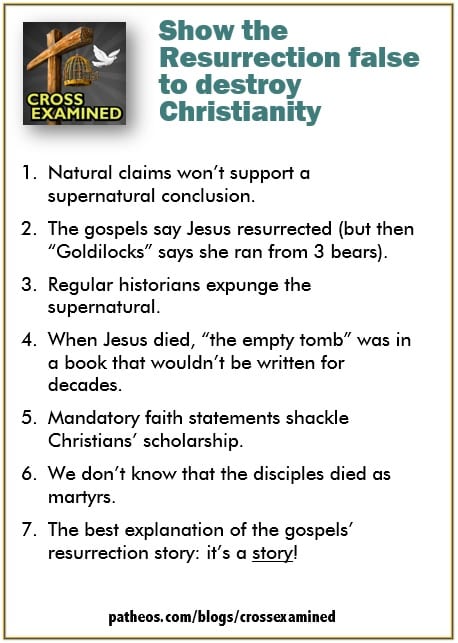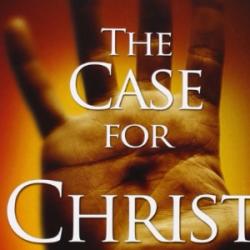Let’s wrap up our critique of the Naysayer Hypothesis.
Recap: this argument says that the gospels were written at a time when many disciples—the eyewitnesses—were still alive. If they heard an inaccurate story about Jesus, they’d correct it. No false story elements would have survived. Said another way, that our gospel story did survive means that it avoided the gauntlet of naysayers and must be true.
We’re exploring this alternate history, where the gospel story was false, and those in the inner circle successfully snuffed it out. It quickly falls apart under examination. Part 1 has the first eight points.
 9. Jesus himself couldn’t rein in rumors. He repeatedly tells those around him to not tell anyone about his miracles, and yet we read about both the miracles and Jesus’s fruitless plea. If he can’t stop rumors, why imagine that mortals can?
9. Jesus himself couldn’t rein in rumors. He repeatedly tells those around him to not tell anyone about his miracles, and yet we read about both the miracles and Jesus’s fruitless plea. If he can’t stop rumors, why imagine that mortals can?
Jesus asked who people thought he was, and he was told, “[some say] John the Baptist; and others say, Elijah; and others, one of the prophets” (Mark 8:28). The gospels themselves say that legendary accretion happened within months. And was Jesus able to play the good naysayer and stamp out the false teaching? Apparently not, if these stories had gone unchecked.
Look at Scientology, cults, or any of the divisions of Christianity, both major (Christian Science, Jehovah’s Witnesses) and minor (thousands of nondenominational churches and sects). Apparently, new religions start quite easily. The incredulous, “But what else could explain the New Testament but that the writers were telling the truth?!” doesn’t hold up when we see how easy it is for a new idea to take hold.
10. One way to stop the gospel story would be naysayers, but a far better way would be to show the gospel story to be false. The gospels themselves document that it was, and even that didn’t stop the story from spreading.
Jesus said that the end would come within the lifetime of many within his hearing. It didn’t (indeed, that this was going to be a longer process than initially thought was a reason that the oral history was finally written down, decades after the events). With the central prediction wrong, what more proof do you need that this religion was false? And yet the religion kept on going.
Or consider Joseph Smith. Here was a man charged with the very occult practices that he then warns about in the Book of Mormon. The Book of Mormon is full of anachronisms. This religion should’ve just collapsed under its own weight, but it’s still here. Logical failings won’t necessarily take down a religion.
These examples make clear that religion can grow in the face of evidence showing that it’s false. It is ridiculous to imagine that naysayers could’ve stopped Christianity when internal falsifying evidence didn’t.
11. Christian apologists say that there were no naysayers correcting a false Jesus story, but how do we know that there weren’t naysayers? For us to know about them, naysayers would need to have written their story and have some mechanism to recopy the true account over and over until the present day. Just like Christian documents, their originals would have crumbled with time. What would motivate anyone to preserve copies of documents that argued against a religion? Perhaps only another religion! And it’s not surprising that the Jesus-isn’t-divine religion didn’t catch on.
We see this problem with noncanonical writings. Take the Gospel of Peter, for example. Our primary copy is from the 8th or 9th century. Why aren’t there older copies as with the four canonical gospels? Because very few copies were made, and no one took pains to preserve them.
12. What success will a naysayer have when he’s fighting a belief that’s taken on faith?
Consider another community that had plenty of evidence that they were on the wrong track. The Millerites made themselves right with God by giving away all their possessions and awaited the end of the world on October 22, 1844. Didn’t happen. What better evidence could one want that William Miller’s Bible-based predictions about the End were false?
Did everyone who’d been duped by this Great Disappointment leave poorer but wiser? Of course not. Many Millerite sects adapted to the new information and carried on, one of which eventually became the Seventh-Day Adventist church.
In our own time, Harold Camping predicted May 21, 2011 for the Rapture, with the end coming five months later. Wrong again. And yet his Family Radio adapted and continues even after its own Great Disappointment.
Here are a few more examples of negative evidence dismissed by true believers:
- Anti-gay pastor Ted Haggard paid for gay sex and meth and was removed as pastor. He’s now back in the saddle. Ditto Jimmy Swaggart (whose weakness was prostitutes). And Jim Bakker (sexual and financial shenanigans). And Peter Popoff (magic tricks masquerading as prophecy). If clear evidence doesn’t sink these preachers for good, why imagine that it would sink the Jesus story?
- An Indian skeptic debunked “tears” from a Catholic crucifix as leaky plumbing. He faces blasphemy charges in India and now lives in Finland.
- Half a million people visited in the first two weeks after the report of an iridescent “Mary” on the window of a bank in Clearwater, Florida. James Randi showed that it was just mineral deposits from sprinklers.
- 9/11 Truthers aren’t convinced by expert testimony.
- Does the appearance of the skeptical correction of a sensational but flawed story on snopes.com, urbanlegends.about.com, James Randi’s Swift, or quackwatch.org quickly shut it down? Of course not.
Believers won’t let rebuttals sink a good story. And when a firmly held conviction is so rarely changed by argument today, why imagine it any more common 2000 years ago?
As an additional humiliation to the Naysayer Hypothesis, consider the Shroud of Turin, a fake burial shroud of Jesus. It came to light in the 14th century, during a time of great interest in Christian relics. History documents dozens of claimed shrouds of Jesus. Though there is still debate on the authenticity of the Turin shroud, our earliest mention of the shroud is a 1390 letter from a bishop to a pope stating not only that it was a forgery but that the artist was known and had confessed.
Apparently the Naysayer Hypothesis is cited only when convenient.
13. The gospel story is just a story. Suppose I pass along the gossip that I heard, “40 years ago, Theodore Mertz rose up from the dead.” Where are the naysayers who will rebut that? There aren’t any. So why be surprised that they don’t leap out of the woodwork to attack my false story with firsthand evidence?
The Naysayer hypothesis has it backwards: it assumes the miracle story, which implies eyewitnesses, and then imagines these eyewitnesses wagging their fingers at anyone who gets the Jesus story wrong. But what if the whole thing is legend? Then we see in history just what we’d expect to see: no eyewitnesses curtailing the Jesus story.
This argument is popular but empty. Don’t use it.
Thanking God for sparing you in a natural disaster
is like sending a thank-you note to a serial killer
for stabbing the family next door.
— Mrs. Betty Bowers,
America’s Best Christian
(This is an update of a post that originally appeared 10/26/12.)
Image credit: Rob Shenk, flickr, CC






 Apologists tell us that the gospels were written at a time when many disciples—the eyewitnesses—were still alive. If they heard an inaccurate story, they’d say, “I was there, and that’s not the way it happened!” They’d shut it down. An incorrect version of the story would not have survived.
Apologists tell us that the gospels were written at a time when many disciples—the eyewitnesses—were still alive. If they heard an inaccurate story, they’d say, “I was there, and that’s not the way it happened!” They’d shut it down. An incorrect version of the story would not have survived.








 The Christian world has plenty of people eager to predict the future. Hal Lindsey published several predictions of the End. Harold Camping hilariously predicted the end of the world in 2011 (I wrote about that
The Christian world has plenty of people eager to predict the future. Hal Lindsey published several predictions of the End. Harold Camping hilariously predicted the end of the world in 2011 (I wrote about that 







